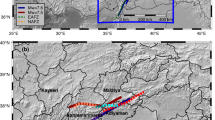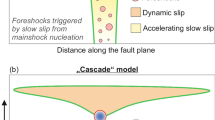Abstract
Rydelek and Horiuchi1 present an analysis of earthquakes in Japan whose magnitudes (M) ranged from 6.0 to 8.0. They determine τpmax, the peak predominant period for P-wave arrival, for the five nearest Hi-net seismic-network stations and plot the event-averaged τpmax versus magnitude. They find no statistically significant trend in their data.
Similar content being viewed by others
Main
The scaling relation between τpmax and magnitude that we presented2 was derived for earthquakes with magnitudes ranging from 3.0 to 8.3. In the analysis of Rydelek and Horiuchi1, all but two of the events are in the magnitude range of 6.0 to 7.1. When a large magnitude range is used, the scaling relation is clear, as shown in Fig. 3a of ref. 2. However, there is also scatter in the magnitude of events with the same τpmax observation. The full range of variability in the event-averaged τpmax that we observed is ±1 magnitude unit. Given the narrow magnitude range used by Rydelek and Horiuchi1, and the variability in τpmax observations as noted by us, it is not possible — and, indeed, we do not expect — to observe a significant trend. Rydelek and Horiuchi1 cannot therefore call into question the existence of a scaling relation between τpmax and magnitude based on their data set. The uncertainty in their event-averaged τpmax observations1 is also increased by their use of only five stations per event; we used all available data within 100 km of each event, which is an average of 26 stations per event.
Our interpretation that earthquake rupture is deterministic is based on the observation that the magnitude can be estimated before rupture is complete. Rydelek and Horiuchi1 have explained that their rationale for using only M≥6.0 events is that the rupture duration for events of M=6.0 is about 4 s, claiming that our τp analysis uses 4 s of data, and therefore that only events with M≥6.0 can be used to determine whether rupture is deterministic (P. Rydelek and S. Horiuchi, personal communication).
Our τp analysis does not use 4 s of data: it uses a maximum of 4 s of data. The actual amount of data used is shown in Fig. 3b of ref. 2, which plots the delay time, τd, at which τpmax is observed with respect to the P-wave trigger, together with the typical rupture duration. For all events that plot below the rupture-duration line, the magnitude can be estimated before rupture cessation, suggesting a deterministic process. This is the case for 58 of the 72 earthquakes in our study. These 'deterministic' events have a magnitude range of 3.3≤M≤8.3 and include all events with M≥4.0.
Rydelek and Horiuchi1 also point out a “break” in the linear trend in τpmax at M=5.5. This is a visual artefact resulting from the criteria used to select the data set. The apparent break results from the fact that all available earthquakes from southern California were combined with M≥6.0 events from other regions around the world. This resulted in fewer events in the 5.5≤M≤6.0 range. It should also be noted that the uncertainty in a magnitude estimate derived from a τpmax scaling relation for a specific region, California for example, is lower than when combining observations from a global data set.
Our interpretation for the observed scaling relation is that a stronger initiation will lead to a rupture that is statistically more likely to propagate further across a heterogeneous fault plane. This has been suggested previously3,4,5 and does not require the largest amount of slip to be at the hypocentre. Although the hypothesis is controversial6,7, another study8 shows that the region of largest slip is statistically near the hypocentre, implying that the location of rupture initiation and peak slip are not independent of one another.
Beyond its implications for the physics of earthquake rupture, rapid magnitude determination can also be used in earthquake-warning systems to provide seconds to tens of seconds of warning before the onset of severe ground-shaking9,10. The Japan Meteorological Agency currently operates an early-warning system that estimates the location and magnitude of an earthquake using P-wave arrivals11. Starting in June 2006, any organization can apply to receive early warnings of earthquakes.
References
Rydelek, P. & Horiuchi, S. Nature 442, 10.1038/nature04963 (2006).
Olson, E. L. & Allen, R. M. Nature 438, 212–215 (2005).
Ellsworth, W. L. & Beroza, G. C. Science 268, 851–855 (1995).
Beroza, G. C. & Ellsworth, W. L. Tectonophysics 261, 209–227 (1996).
Heaton, T. H. Phys. Earth Planet. Int. 64, 1–20 (1990).
Kilb, D. & Gomberg, J. J. Seismol. 3, 409–420 (1999).
Mori, J. & Kanamori, H. Geophys. Res. Lett. 23, 2437–2440 (1996).
Mai, P. M., Spudich, P. & Boatwright, J. Bull. Seismol. Soc. Am. 95, 965–980 (2005).
Allen, R. M. Seismol. Res. Lett. 77, 371–376 (2006).
Lockman, A. B. & Allen, R. M. Bull. Seismol. Soc. Am. 95, 2029–2039 (2005).
Kamigaichi, O. J. Jpn Assoc. Earthquake Eng. 4, no.3 (2004).
Author information
Authors and Affiliations
Corresponding author
Rights and permissions
About this article
Cite this article
Olson, E., Allen, R. Is earthquake rupture deterministic? (Reply). Nature 442, E6 (2006). https://doi.org/10.1038/nature04964
Published:
Issue Date:
DOI: https://doi.org/10.1038/nature04964
This article is cited by
-
\(\varvec{\tau}_{ps}\) τ p s , a new magnitude scaling parameter for earthquake early warning
Bulletin of Earthquake Engineering (2018)
-
A frequency-based parameter for rapid estimation of magnitude
Journal of Theoretical and Applied Physics (2017)
Comments
By submitting a comment you agree to abide by our Terms and Community Guidelines. If you find something abusive or that does not comply with our terms or guidelines please flag it as inappropriate.



